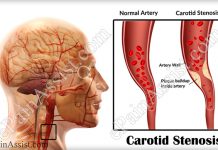Aorta
What Causes An Aneurysm In The Aorta?
An aneurysm in aorta occurs due to weakening of the blood vessel. Such weakening can cause for a variety of factors. In order to prevent aortic aneurysm one must eat healthy, quit smoking and try living a stress-free life.
Abdominal Aortic Aneurysm
Abdominal Aortic Aneurysm Symptoms Include Moist Skin, Dizziness, Nausea etc. Know the Pathophysiology, Causes, Risk Factors, Signs, Symptoms, Tests, Treatment.
What is Coarctation of the Aorta or Aortic Narrowing & What are its Causes, Symptoms
Coarctation of the aorta refers to the narrowing of the aorta. The exact reason causing coarctation of the aorta or aortic narrowing is not known by the researchers. Adults having this condition do not exhibit symptoms and this may be because the narrowing of the aorta is less severe.
Blood Pressure
Ideal Blood Pressure for Men and Women
Ideal blood pressure is considered as 120/80 mm of Hg and is not much different for men and women. However, blood pressure in women may be slightly lower than in men of the same age.
Can High Blood Pressure Cause Nosebleeds?
This article explain how high blood pressure can be related to nosebleeds. When the blood pressure is very high then a variety of symptoms are caused including nosebleeds, although this occurrence is pretty rare.
When to Worry About High Blood Pressure?
Under normal circumstances, it is advised to consult a physician when the blood pressure numbers are above or below the normal limits. In case of any major deviations from the normal blood pressure, it is a warning sign and requires immediate medical attention.
Chest
Chest Muscle Strain
Chest Muscle Strain which is also known by the name of Pectoral Muscle Strain. The best way to treat Chest Muscle Strain is by treating it conservatively. Know the causes, symptoms, treatment and recovery period for grade I, II, III strain of chest muscles.
What Can Cause Burning Chest Pain and How is it Treated?
Burning chest pain is a common symptom experienced in many conditions that affect the heart, lungs, chest region and also the gastric tract. Gastric causes are the commonest causes of burning pain in chest region.
What Is Substernal Chest Pain?
Know what is substernal chest pain and its causes, symptoms, treatment and diagnosis.
Heart
Myocarditis or Inflammation of Heart Muscles
Learn more about Myocarditis or Inflammation of Heart Muscles, Possible Causes, Symptoms, Treatment, Personal Experiences.
Heart Attack or Myocardial Infarction (MI)
Recovering from a Heart Attack or Myocardial Infarction (MI) depends on the patient’s lifestyle, frequency and duration of exercise, stress handling, diet etc. Know the Causes, Risk Factors, Symptoms, Treatment, Tests.
Congenital Heart Disease
Earlier Congenital Heart Disease was considered as potentially a fatal condition but with the advancements made in the field of medical science and the technology children are able to successfully survive for a much longer period of time.
Systemic Diseases
Leukocytoclastic Vasculitis
Leukocytoclastic Vasculitis is a rare condition and not much information is available about this disorder. However, it is a fact that Leukocytoclastic Vasculitis is quite well treated with no fatality associated with it under normal circumstances.
What is Granulomatosis with Polyangiitis & How is it Treated?
Granulomatosis polyangiitis is a disorder of the vascular system. The condition is presented as polyangiitis and granulomatosis. Granulomatosis Polyarteritis is a form of inflammation of small and medium sized vessels in multiple organs. Know the causes, signs, symptoms, treatment, prognosis of Granulomatosis polyangiitis.
Urticarial Vasculitis
Urticarial Vasculitis can be defined as a type of Cutaneous Vasculitis that is indicated by the inflammation of the walls of the small blood vessels. Know the causes, symptoms, treatment, Prognosis, and epidemiology of Urticarial Vasculitis.
Vascular Disease
Recovery Period of Peripheral Artery Disease & its Prognosis
The healing time/recovery period for peripheral artery disease depends on many factors, you specialist is the right person to consult regarding the recovery period. Even though the prognosis is good for peripheral artery disease, it all depends on the patient.
Critical Limb Ischemia
Critical Limb Ischemia (CLI), commonly known as limb threat, is the advanced and severe stage of Peripheral artery disease and needs treatment by a vascular specialist or surgeon. Know the types, causes, symptoms, risk factors, treatment and diagnosis of Critical Limb Ischemia.
What is Carotid Stenosis or Stenosis of the Carotid Artery & How is it Treated?
Carotid Stenosis or Stenosis of the Carotid Artery is a pathological condition in which there gradual narrowing of the carotid arteries. A stroke can occur due to Carotid Stenosis or Stenosis of the Carotid Artery.


















